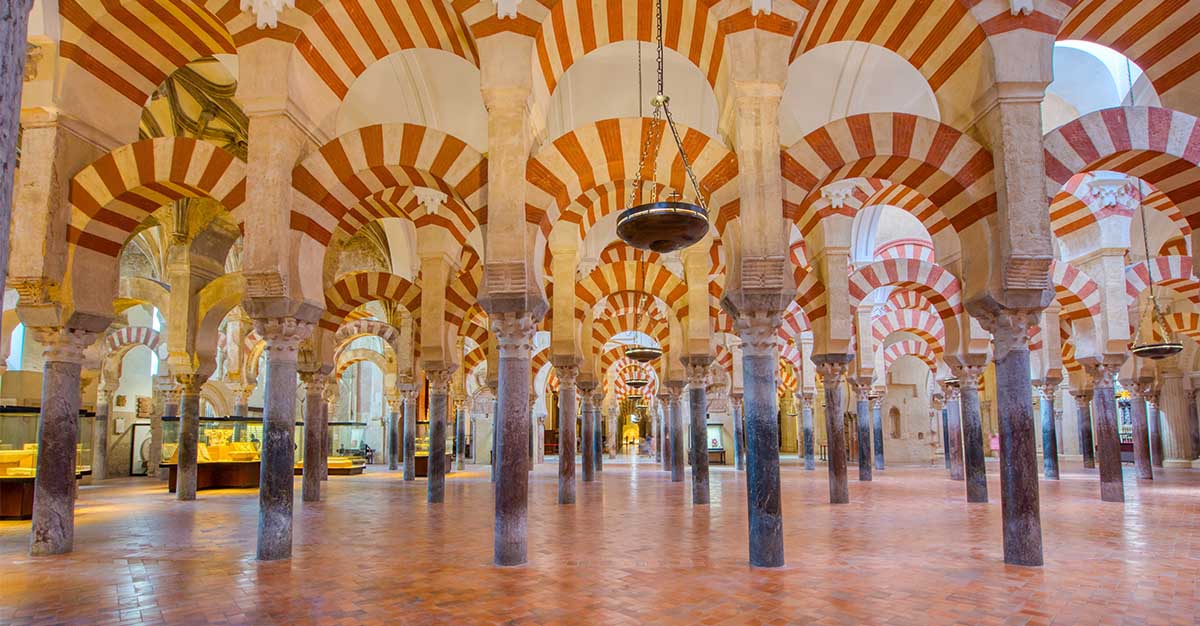As my family negotiated the narrow, winding street, well before reaching our destination, we could hear the tumult ahead. It led us to a square overwhelmed with sightseers. This could have been any tourist trap in Europe. We battled through a surging tide of humanity toward the walled entrance of the Mezquita-Catedral, Córdoba.
A dozen gift stores peddling tawdry artefacts lined up for inspection. To each were attached sinewy queues of school-goers and elderly couples clutching each other for support. Ice cream parlours and snack bars were subjected to the same fate.
We gingerly stepped over sticky chocolate wrappers, blobs of chewing gum and discarded plastic pop bottles. We vied for a foothold among streams of tourists desperate to keep up with their guides, who brandished pennants atop fully extended silvery car aerials that glistened in the sun. Guitar players strummed Joaquin Rodrigo while perched upon discoloured brick embarkments in front of the walled Mezquita. Chaos reigned, with neither dignity nor reverence for the third largest mosque in the world.
Trudging through a gated entrance, we entered the Mezquita’s forecourt. What had once been a lawn the size of a football pitch, raised six inches above the ground, was now mostly upturned rust-orange soil. With no sign to advise visitors to keep off the meagre grass, groups of students balanced on their haunches, huddled in small circles, twiddling with their phones. The lucky ones found shelter from the sun’s grinding blaze under a handful of trees struggling to survive. The lineups were endless. Thank goodness I had purchased tickets in advance.
Laura and our two boys didn’t look well at all. Drooping from the relentless heat, they fell into a silent torpor.
From glaring sunlight, we entered cool refreshing shade. Hundreds of arches—nine feet tall, of beige and wine-red marble—loomed through the darkness at us. Each colour was layered one atop the other, transforming the arches into variegated stripes. Their splendour and excess spoke to the power of the Muslim Moors when Cordova (now called Córdoba) was their capital, from which they governed the bulk of Spain for centuries. An Arab scholar described the architecture as “countless pillars like rows of palm trees swaying in the oases of Syria.” Even in darkness, they took my breath away. The whole family stood transfixed.
Our commune was shattered by the howl of a child barging into us. Loud, brash voices echoed throughout this gigantic prayer hall, punctuated by the flash of cameras. The air in the hall was musty, its floor layered in dust.
In Africa, I accompanied my aunt each morning to market. On our way, we would tarry awhile at our mosque to make our obeisance. At that hour, rows of women volunteers, their backs hunched, swept clean the rush-matted marble floor. Where were the sweepers today? This sacred place of worship was now transmuted into a theme park, with kids let rampant, treating this shrine as their personal playground.
When the Spaniards recaptured their land, they obliterated all signs of Arabia until recent times. Mosques were converted into churches. Chapels were installed within the Mezquita, along with a cruciform nave and transept. Observing the bloated crowd around me, this new-found Spanish enthusiasm for its Moorish past and its culture convinced me, more than ever, that it was a ploy to lure more visitors and their lucre to resuscitate the country’s moribund economy.
I directed Laura to a place where she, as a practising Catholic, could light a candle and dedicate a prayer. My two boys were cut loose with a promise to return within half-an-hour. I was left alone to find my own place of belonging.
Peace was interrupted within minutes.
“Pops, pops, come see this!” Invigorated by the cooler temperature indoors, the boys’ voices shook with excitement.
They hauled me hurriedly to the other end of the Mezquita, to a lighted glass cabinet displaying cartouches—small tablets of sparkling white stone—each bearing the hallmark of master builders of this grand edifice. Why this was so important to the boys, I couldn’t fathom. Then it dawned on me. The boys had carved cartouches at school. They saw the Mezquita as just another ancient curiosity, with no visceral connection. The closest they felt was in their common experience with cartouches, while Laura was drawn directly to the chapels and offertories to connect with her own faith.
What of myself? I visualized the Mezquita as it should have been—a functioning mosque. I drew a comparison to my own mosque in Africa, where the congregation came to pray and, in so doing, coalesced as one, within its tranquility. Half a century later, it was still so vivid. The Mezquita should have been more than a relict, swaying onlookers with its intrinsic beauty. It had been robbed of its soul.


